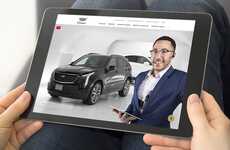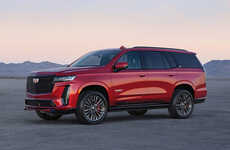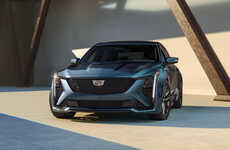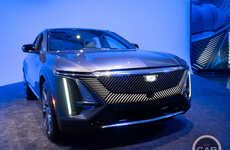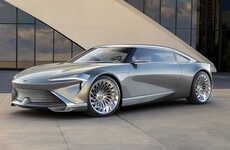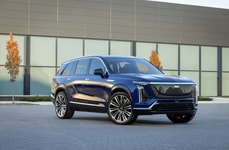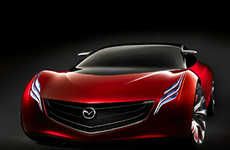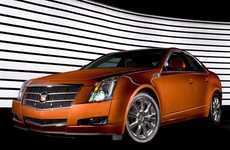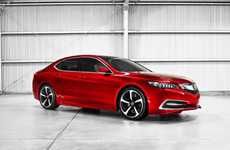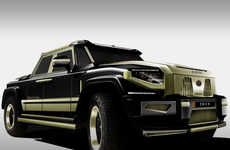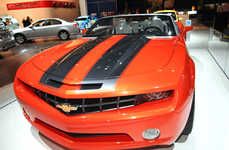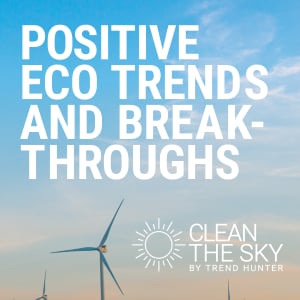
Bryan Nesbitt, Cadillac General Manager, On Caddy's Evolution
Marissa Brassfield — December 3, 2009 — Autos
References: cadillac
Cadillac General Manager Bryan Nesbitt has much to be proud of at the 2009 LA Auto Show. The modern Cadillac fleet isn’t just for grandparents—the CTS-V, CTS Coupe and the 2010 SRX Crossover demonstrate the luxury brand’s appeal to tastemakers of any age. I had the opportunity to sit down with Bryan Nesbitt on Wednesday to talk about the roles branding and social media play in the evolution of Cadillac.
Cadillac has the cultural cachet, but with the CTS and Escalade lines especially, each car is closely integrated with a lifestyle. What other lifestyle integrations are being made with the current Cadillac fleet?
We’re going through a lot of changes. I came in on August 1, and it was clear that we weren’t doing enough in the right areas, like our digital, our print, our asset collection, and what we were doing on a social level. Some of it is due to funding, but in other areas, it’s just the amount of attention paid. I found we didn’t have a lot of priority in digital, which was a big problem. We’re actually in a full agency review right now, and I suspect we’ll come to a conclusion in January, where we’ll end up with our agency of record. At that point, we’ll be readdressing everything about how we go to market.
In the meantime, we’ll be doing some other things. What we find is that there are a lot of customers who want to validate the quality [of our cars], and there’s sometimes, depending on age and other characteristics, a trust issue.
What we’ve been trying to do is create certain types of events where we can bring in the target competitive set with our vehicle. People don’t really want to go to a dealership to compare their vehicle—they don’t really want to be bothered, in a way. It has to be pretty convenient, so we find areas that intersect with them, not unlike pop-up retail, where you’re going to [the consumer], in their location and their zip code, and then offering them the chance to just come to conclusions on their own. There’s no selling involved—just a chance to drive.
We’ve been doing some of those events for the new Cadillac SRX, and we believe we’ve got a very competitive entry against some of the other pieces in the segment. What we want to do is provide a chance for people to come to their own conclusions about that. These are epicurean events; we’ll go to a robust location rich with arts and entertainment—I just went to LA Live Last night—very happening types of places, but well-heeled, of course, so we’re talking to the right people, and it’s very focused. We’ll bring in a celebrity chef or another figure that brings in some interest on an emotional level, and then we provide the vehicles right there.
We find that, for instance, people find our interiors very appealing, but they don’t expect Cadillac to have appealing interiors. We’ve got a lot of old Cadillac DeVilles still out on the road, so there’s almost a false perception of what’s happening, and a gap versus what we’re really producing right now. We have a very distinct identity—all brands have to now—but once you get people inside the cars and you can show them some features, like our touchscreen navigation system, we believe there’s a lot of opportunity there, complementing how people use technology. It’s all about being able to bring people to a place where they can see these differences, use their senses and come to their own judgments. Then it’s up to them to see if they want to pursue the car further, and we’re finding that’s [a] pretty successful [strategy].
There are other things we’ve been doing too, like our CTS-V Challenge at Monticello Motor Club. Those are ways where we’re trying to be creative and communicate the robustness of the engineering and the robustness of the hardware. And we’ve got the hardware. It’s just that many people don’t naturally expect us to, or don’t naturally come to the conclusion, “Oh yeah, Cadillac always has the best,” and so [there are] creative ways that we can try to imply that message. It turned out to be a neat event for everybody that participated.
How much (or little) will social media play in getting that message out?
I think we’re all kind of trying to figure out how to use social media as a proper tool without being a consistent message meant solely to push sales—how to keep it transparent. Your first impressions [with social media] are that you need to blog constantly. You’re almost intimidated by the time demands. How do we do that, without tarnishing the brand? The other piece is that we do want to find ways to use social media. People are passionate about luxury vehicles, they’re passionate about sports sedans and coupes. They’re passionate about these types of precise hardware vehicles, and they want to talk about it, and we want to be a part of the conversation. It’s just, what’s the right way?
So we’re looking at a lot of different things—finding an agency that can help us, that knows more about social media than we do. We know about cars. We are not social media experts. We make cars, and we try to make really good ones. But when people say to me, “You guys aren’t acting like social media experts,” my response is, “I am not an expert in social media.”
We concentrate on making really good vehicles, we concentrate on trying to make a good dealership experience. We’re going to be redoing all of our dealerships. You know how our minds work: Everything we see, we immediately start to judge and make an impression and stereotype, so everything has to be respected and thought about and visually articulated to a standard. We haven’t been very consistent with that at all.
If you don’t take care of all those little pieces—like if the website takes too long to load—anything can send the wrong message. It immediately becomes a judgment of the brand itself. Because we have some of these trust issues, we have to be sure. We can’t take a risk on any single interface that the customer might experience. I’m going through and identifying everything so that we can raise it to a higher level standard—an aesthetics standard, a quality standard—and we’re going to do that in every piece of the business.
We just finished all the changes that we’re going to make, and it’s quite tasteful and something that’ll have a very long shelf life. I’m excited about all of those things.
We’re excited too, Bryan! Thank you for your time.
Cadillac has the cultural cachet, but with the CTS and Escalade lines especially, each car is closely integrated with a lifestyle. What other lifestyle integrations are being made with the current Cadillac fleet?
We’re going through a lot of changes. I came in on August 1, and it was clear that we weren’t doing enough in the right areas, like our digital, our print, our asset collection, and what we were doing on a social level. Some of it is due to funding, but in other areas, it’s just the amount of attention paid. I found we didn’t have a lot of priority in digital, which was a big problem. We’re actually in a full agency review right now, and I suspect we’ll come to a conclusion in January, where we’ll end up with our agency of record. At that point, we’ll be readdressing everything about how we go to market.
In the meantime, we’ll be doing some other things. What we find is that there are a lot of customers who want to validate the quality [of our cars], and there’s sometimes, depending on age and other characteristics, a trust issue.
What we’ve been trying to do is create certain types of events where we can bring in the target competitive set with our vehicle. People don’t really want to go to a dealership to compare their vehicle—they don’t really want to be bothered, in a way. It has to be pretty convenient, so we find areas that intersect with them, not unlike pop-up retail, where you’re going to [the consumer], in their location and their zip code, and then offering them the chance to just come to conclusions on their own. There’s no selling involved—just a chance to drive.
We’ve been doing some of those events for the new Cadillac SRX, and we believe we’ve got a very competitive entry against some of the other pieces in the segment. What we want to do is provide a chance for people to come to their own conclusions about that. These are epicurean events; we’ll go to a robust location rich with arts and entertainment—I just went to LA Live Last night—very happening types of places, but well-heeled, of course, so we’re talking to the right people, and it’s very focused. We’ll bring in a celebrity chef or another figure that brings in some interest on an emotional level, and then we provide the vehicles right there.
We find that, for instance, people find our interiors very appealing, but they don’t expect Cadillac to have appealing interiors. We’ve got a lot of old Cadillac DeVilles still out on the road, so there’s almost a false perception of what’s happening, and a gap versus what we’re really producing right now. We have a very distinct identity—all brands have to now—but once you get people inside the cars and you can show them some features, like our touchscreen navigation system, we believe there’s a lot of opportunity there, complementing how people use technology. It’s all about being able to bring people to a place where they can see these differences, use their senses and come to their own judgments. Then it’s up to them to see if they want to pursue the car further, and we’re finding that’s [a] pretty successful [strategy].
There are other things we’ve been doing too, like our CTS-V Challenge at Monticello Motor Club. Those are ways where we’re trying to be creative and communicate the robustness of the engineering and the robustness of the hardware. And we’ve got the hardware. It’s just that many people don’t naturally expect us to, or don’t naturally come to the conclusion, “Oh yeah, Cadillac always has the best,” and so [there are] creative ways that we can try to imply that message. It turned out to be a neat event for everybody that participated.
How much (or little) will social media play in getting that message out?
I think we’re all kind of trying to figure out how to use social media as a proper tool without being a consistent message meant solely to push sales—how to keep it transparent. Your first impressions [with social media] are that you need to blog constantly. You’re almost intimidated by the time demands. How do we do that, without tarnishing the brand? The other piece is that we do want to find ways to use social media. People are passionate about luxury vehicles, they’re passionate about sports sedans and coupes. They’re passionate about these types of precise hardware vehicles, and they want to talk about it, and we want to be a part of the conversation. It’s just, what’s the right way?
So we’re looking at a lot of different things—finding an agency that can help us, that knows more about social media than we do. We know about cars. We are not social media experts. We make cars, and we try to make really good ones. But when people say to me, “You guys aren’t acting like social media experts,” my response is, “I am not an expert in social media.”
We concentrate on making really good vehicles, we concentrate on trying to make a good dealership experience. We’re going to be redoing all of our dealerships. You know how our minds work: Everything we see, we immediately start to judge and make an impression and stereotype, so everything has to be respected and thought about and visually articulated to a standard. We haven’t been very consistent with that at all.
If you don’t take care of all those little pieces—like if the website takes too long to load—anything can send the wrong message. It immediately becomes a judgment of the brand itself. Because we have some of these trust issues, we have to be sure. We can’t take a risk on any single interface that the customer might experience. I’m going through and identifying everything so that we can raise it to a higher level standard—an aesthetics standard, a quality standard—and we’re going to do that in every piece of the business.
We just finished all the changes that we’re going to make, and it’s quite tasteful and something that’ll have a very long shelf life. I’m excited about all of those things.
We’re excited too, Bryan! Thank you for your time.
Trend Themes
1. Luxury Car Lifestyle Integration - Opportunity to create epicurean events for consumers to validate the quality of the car and offer them a chance to just drive.
2. Social Media for Luxury Automobile Branding - Opportunity to find ways to use social media to tap into consumers' passion for luxury automobiles and sports sedans and coupes, without tarnishing the brand.
3. Digital Strategy for Luxury Automobile Marketing - Opportunity to raise the standard to a higher level, aesthetics standard and quality standard for all digital interfaces, such as websites, to eliminate trust issues and attract high-end customers.
Industry Implications
1. Luxury Automobile Manufacturing - Opportunity to integrate cars with consumers' lifestyle and leverage social media, as well as to improve digital strategies, to stay competitive in the luxury automobile market.
2. Luxury Automobile Dealerships - Opportunity to enhance the dealership experience and create an aesthetics standard for all visual interfaces, to improve the brand image and customer trust.
3. Advertising & Marketing Agencies - Opportunity to become experts in social media to help luxury automobile brands leverage this tool to communicate with passionate consumers, without compromising the brand image.
3.7
Score
Popularity
Activity
Freshness

